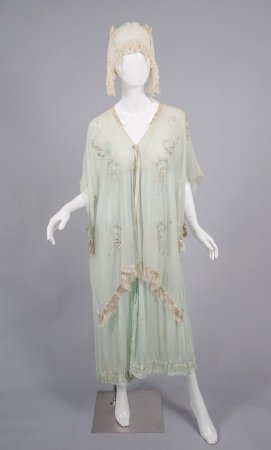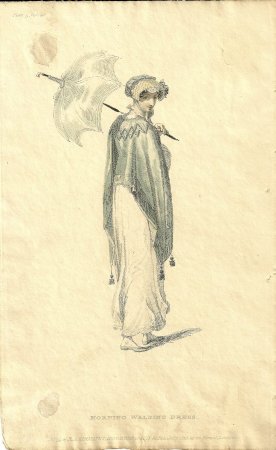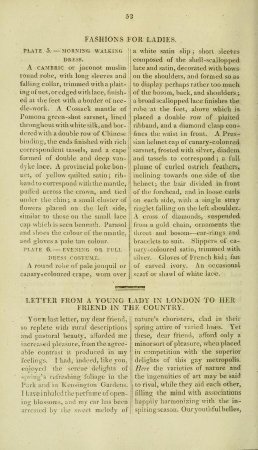Object ID:
2013.4.14
Label/Maker:
Ackermann, Rudolph
Date:
July 1, 1813
Learn More:
Object Story:
This hand-colored Akerman illustration depicts a young lady in a white morning walking dress. "The popularity of muslin dresses began in the late 1780s when the artist Elisabeth Louise Vigée Le Brun depicted the stylish Marie Antoinette in a plain muslin dress." Bursts of blue are shown in the mantle, bonnet, and ballet flats in keeping with Regency fashion statements that often included accessories that contrasted with empire gowns. An open parasol provides protection from the sun while finishing the look. The walking dress also includes a high ruff collar and long sleeves for morning strolls. The silken mantle has fringe-like trim with tassels on each end, as well as a doubled-layered decorative edging near the neckline. Tassels were a significant design embellishment in both home decor and fashion during the Neoclassic era.
Symbolic Comparison:
These pieces convey both wealth and elegance through the use of flowing textiles. The European demand for silk and cottons continued to expand throughout the 18th century as a symbol of fashion refinement, social status, and leisure.25 Both the morning walking dress and the peignoir are examples of female style which exemplified their respective time period's lack of focus on a constructed silhouette. "The development of a more convenient, modern female wardrobe was a major trend of the 1920s and was achieved through the progressive simplification of dress as the decade advanced--- a rejection of formality and multiple layers, in favor of comfort and a lighter, more natural effect."26 In each case, both designs provide the ability for movement and comfort as well as creating a sensual allure as the textile cascades over the figure.
References:
24 "Peignoir," The Metropolitan Museum, accessed November 25, 2020. https://www.metmuseum.org/art/collection/search/759005.
25 Daniel C Waugh, "Silk," accessed November 25, 2020, https://depts.washington.edu/silkroad/exhibit/trade/silkae.html.
26 Karina Reddy, "1920-1929," Fashion History Timeline, May 11, 2018. https://fashionhistory.fitnyc.edu/1920-1929/.
25 Daniel C Waugh, "Silk," accessed November 25, 2020, https://depts.washington.edu/silkroad/exhibit/trade/silkae.html.
26 Karina Reddy, "1920-1929," Fashion History Timeline, May 11, 2018. https://fashionhistory.fitnyc.edu/1920-1929/.



